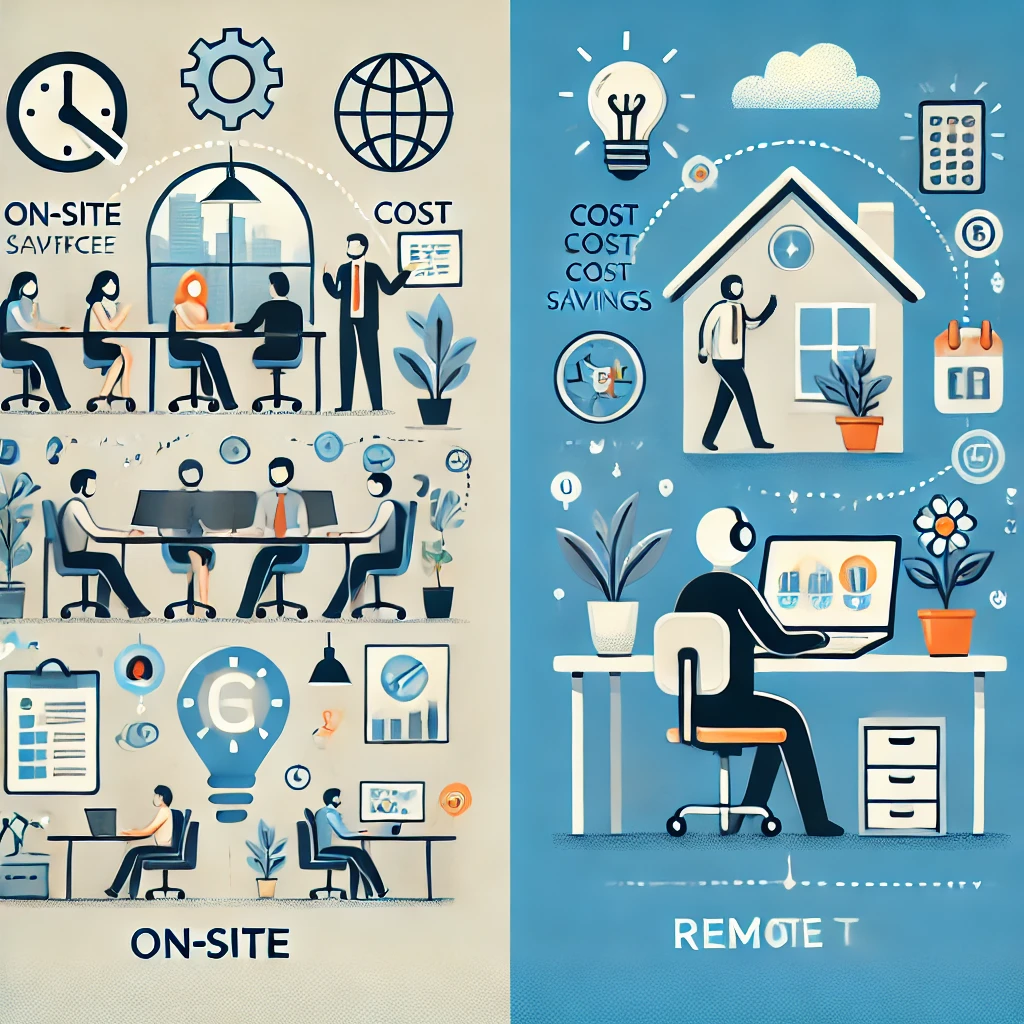On-Site vs Remote Jobs: A Comprehensive Comparison
- Posted by Daan de Jong (Netherlands)
- Categories Jobs Around The World
- Date July 22, 2024
Understanding On-Site and Remote Jobs
What are On-Site Jobs?
On-site jobs require employees to be physically present at a specific location, such as an office, factory, or retail store. These roles often involve direct interaction with colleagues and customers and typically adhere to a fixed schedule.
What are Remote Jobs?
Remote jobs, on the other hand, allow employees to work from anywhere, often from home, using digital tools and communication platforms. This flexibility can lead to a better work-life balance and reduced commuting time.
Key Differences Between On-Site and Remote Jobs
Workplace Environment
- On-Site Jobs: Employees work in a structured environment with designated workspaces, regular hours, and direct supervision.
- Remote Jobs: Employees have the flexibility to create their own workspace, often leading to a more personalized and comfortable environment.
Communication and Collaboration
- On-Site Jobs: Face-to-face interactions facilitate real-time communication and collaboration.
- Remote Jobs: Digital tools like Zoom, Slack, and Microsoft Teams are essential for communication, which can sometimes lead to delays and misunderstandings.
Work-Life Balance
- On-Site Jobs: Fixed schedules can sometimes make it challenging to balance personal and professional responsibilities.
- Remote Jobs: Flexible schedules allow for a better balance between work and personal life, though it can blur the lines between the two.
Pros and Cons of On-Site and Remote Work
Pros of On-Site Jobs
- Direct supervision and immediate feedback.
- Enhanced team bonding and collaboration.
- Access to office resources and infrastructure.
Cons of On-Site Jobs
- Commute time and associated costs.
- Rigid schedules and less flexibility.
- Potential for workplace distractions and interruptions.
Pros of Remote Jobs
- Flexibility in work hours and location.
- No commute, saving time and money.
- Potential for increased productivity and job satisfaction.
Cons of Remote Jobs
- Isolation and lack of social interaction.
- Dependence on technology and reliable internet.
- Challenges in separating work from personal life.
Benefits of Remote Work vs On-Site
Flexibility and Autonomy
Remote jobs offer greater flexibility and autonomy, allowing employees to manage their own schedules and work from any location. This flexibility can lead to higher job satisfaction and better work-life balance.
Cost Savings
Both employees and employers can benefit from cost savings with remote work. Employees save on commuting costs, while employers can reduce overhead expenses related to office space and utilities.
Increased Productivity
Studies have shown that remote workers can be more productive due to fewer distractions and a more comfortable work environment. However, this can vary depending on individual work habits and the nature of the job.
Productivity Comparison: Remote Work vs Office Work
Working from Home vs Office Productivity
Productivity levels can differ significantly between remote and on-site work. While remote work offers flexibility and a comfortable environment, it also requires strong self-discipline and time management skills.
- Remote Work Productivity Factors:
- Ability to create a focused work environment.
- Effective use of digital tools for communication and collaboration.
- Personal accountability and time management.
- On-Site Work Productivity Factors:
- Immediate access to resources and support.
- Direct supervision and structured schedules.
- Team collaboration and motivation.
Remote Work vs On-Site Work Analysis
Statistical Analysis of On-Site vs Remote Jobs
Analyzing the statistics of on-site vs remote jobs reveals interesting trends and insights. According to a Gallup report, remote work has grown significantly, with 43% of employees working remotely at least some of the time. This shift has been driven by advancements in technology and changing employee preferences.
Remote Work versus On-Site Work Trends
The trend towards remote work is expected to continue, with more companies adopting flexible work policies. This shift is influenced by factors such as cost savings, employee satisfaction, and technological advancements.
Comparing Remote Jobs and Office Jobs
Advantages of Remote Jobs Compared to On-Site Jobs
Remote jobs offer several advantages over on-site jobs, including flexibility, cost savings, and increased productivity. However, it’s essential to address the challenges associated with remote work, such as isolation and the need for reliable technology.
On-Site vs Remote Job Statistics
Statistical data indicates a growing preference for remote work, particularly among younger employees who value flexibility and work-life balance. Companies are also recognizing the benefits of remote work, leading to increased adoption of remote work policies.
In conclusion, the comparison between on-site & remote jobs highlights the unique advantages and challenges of each work arrangement. On-site jobs offer structure, direct supervision, and team collaboration, while remote jobs provide flexibility, cost savings, and potential productivity gains. As the trend towards remote work continues, understanding these differences and benefits will help individuals and organizations make informed decisions about their work arrangements.
For more insights into work trends and other educational resources, visit Regent Studies. To stay updated with the latest developments in the workplace, consider following reputable sources like Gallup.
By leveraging the benefits of both on-site and remote jobs, employees and employers can create a more balanced and productive work environment, tailored to the needs of the modern workforce. Whether you are evaluating the benefits of remote work vs on-site or analyzing productivity trends, this comprehensive comparison provides valuable insights for making informed decisions.
Next post
Understanding the Difference Between Copywriting and Content Writing: A Comprehensive Guide
You may also like

EU Blue Card in Luxembourg: Requirements and Eligibility Criteria



